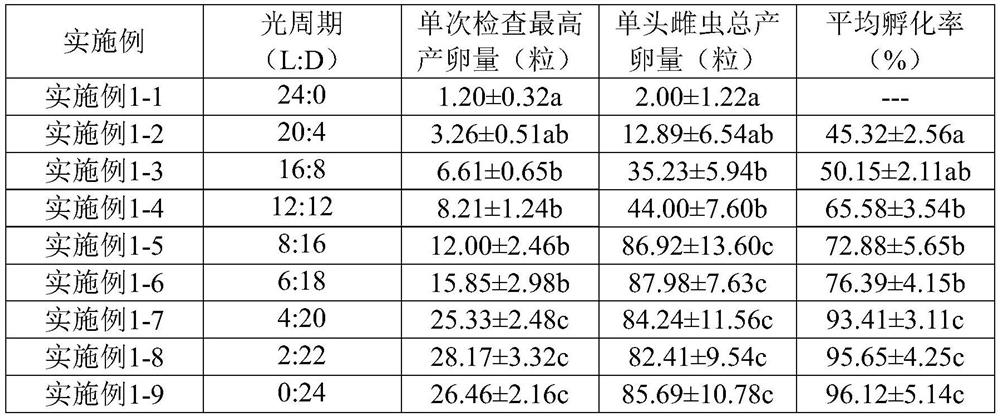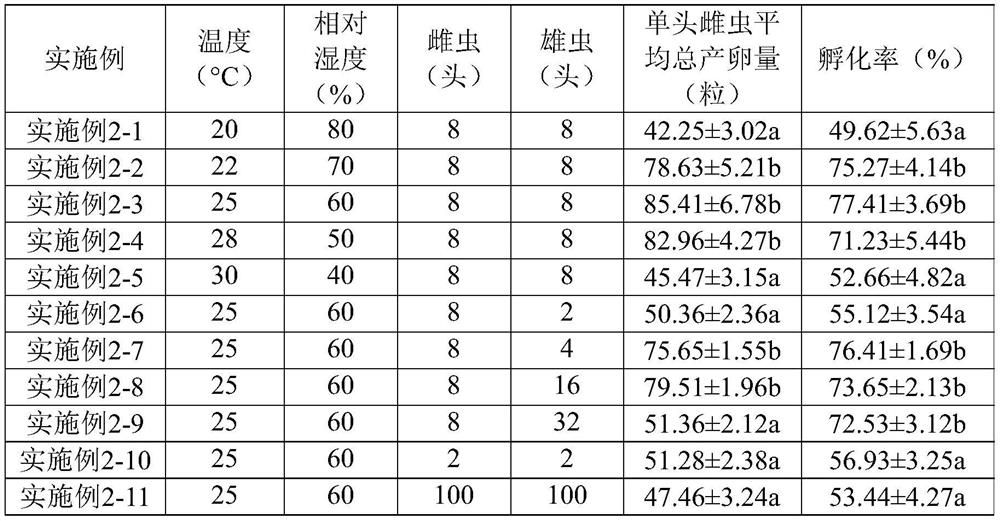A kind of artificial rearing method of gill beetle adults and larvae
A technology of beetles and adults, which is applied in the field of artificial breeding of beetles adults and larvae, can solve the problems that the egg production is greatly affected by environmental factors, adults and larvae are easily infected with Beauveria bassiana and nematodes, and the survival rate of larvae is low. , to achieve the effect of increasing the hatching rate, increasing the average egg production, and benefiting the hatching of eggs
- Summary
- Abstract
- Description
- Claims
- Application Information
AI Technical Summary
Problems solved by technology
Method used
Image
Examples
Embodiment 1
[0058] Breeding soil components and production methods: 75 parts by mass of sandy soil, baked at 150°C for 2 hours, aired to room temperature, mixed with 20 parts by mass of peanut shell powder with a particle size of less than 10 mesh, and 5 parts by mass of plant ash, and prepared the soil with sterile water After the humidity is 18%, pass through a 10-mesh sieve.
[0059] Disinfection method of breeding environment and feeding utensils: use 3g / m3 in breeding room and indoor artificial climate incubator before use 3 Sodium dichloroisocyanurate was fumigated for 18 hours in a closed manner, and ventilated for 36 hours after fumigation. The daily disinfection during the rearing period is to use 3g / m2 after removing the adult feeding box every week. 3 Sodium dichloroisocyanurate is fumigated for 0.5 hours in the rearing room and the indoor artificial climate incubator, and used after ventilation for 1 hour.
[0060] Before use, the feeding utensils were soaked and disinfected...
Embodiment 2
[0068] Raising soil components and production methods: 75 parts by mass of sandy soil, baked at 150°C for 3 hours, aired to room temperature, mixed with 20 parts by mass of peanut shell powder with a particle size of less than 10 mesh, and 5 parts by mass of plant ash, and prepared the soil with sterile water After the humidity is 20%, pass through a 10-mesh sieve.
[0069] Disinfection method of breeding environment and feeding utensils: use 3g / m3 in breeding room and indoor artificial climate incubator before use 3 Sodium dichloroisocyanurate was fumigated for 24 hours in a closed fumigation, and ventilated for 48 hours after fumigation. The daily disinfection during the feeding period is to use 3g / m2 after removing the adult feeding box every 10 days. 3 Sodium dichloroisocyanurate is fumigated for 1 hour in the rearing room and the indoor artificial climate incubator, and used after ventilation for 1 hour. Feeding utensils include feeding boxes, medicine spoons, tweezers,...
Embodiment 3
[0079] Raising soil components and production methods: 75 parts by mass of sandy soil, baked at 100°C for 4 hours, aired to room temperature, mixed with 20 parts by mass of peanut shell powder with a particle size of less than 10 mesh, and 5 parts by mass of plant ash, and prepared the soil with sterile water After the humidity is 18%, pass through a 10-mesh sieve.
[0080] Breeding room and indoor artificial climate incubator and feeding utensils were disinfected before use and daily disinfection during feeding according to the medicament and dosage in Table 3, respectively.
[0081] The breeding room was fumigated and sterilized with a fumigant for 18 hours before use, and ventilated for 36 hours after fumigation.
[0082] The daily disinfection is to take out the adult feeding box every week and fumigate it for 0.5 hours, and then use it after ventilating for 0.5 hours.
[0083] The breeding utensils should be soaked and disinfected with disinfectant for 6 hours before use...
PUM
 Login to View More
Login to View More Abstract
Description
Claims
Application Information
 Login to View More
Login to View More - R&D
- Intellectual Property
- Life Sciences
- Materials
- Tech Scout
- Unparalleled Data Quality
- Higher Quality Content
- 60% Fewer Hallucinations
Browse by: Latest US Patents, China's latest patents, Technical Efficacy Thesaurus, Application Domain, Technology Topic, Popular Technical Reports.
© 2025 PatSnap. All rights reserved.Legal|Privacy policy|Modern Slavery Act Transparency Statement|Sitemap|About US| Contact US: help@patsnap.com



